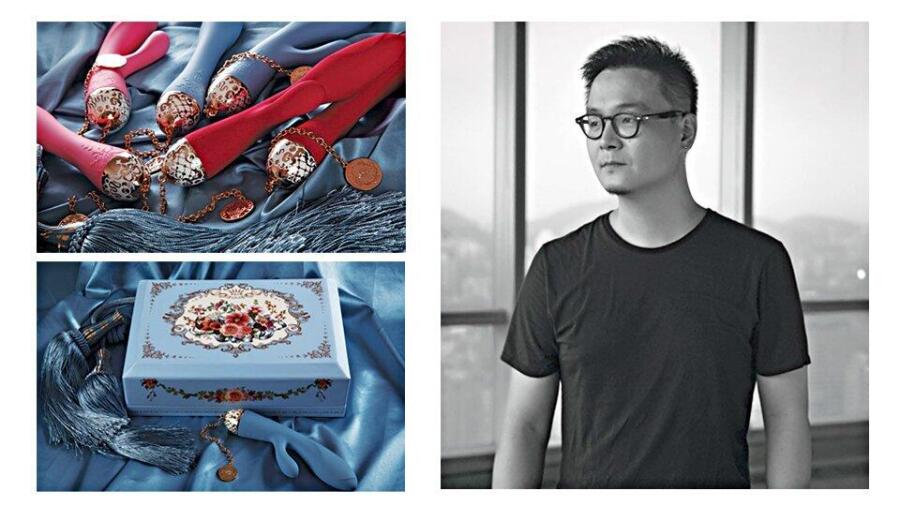If orgasms aren’t enough to make you feel like a pleasure goddess, take a twirl around your sensual parts with one Zalo’s flirty, femme-themed vibes. With lush colors, rich brand stories, and designer jewelry details, this boutique company seeks to unleash the most feminine of sexual fantasies.
Zalo, a Chinese-born company with several sales hubs around the globe, is turning sex toys into luxury works of art. Sexual seekers can take their pick from four luscious brand lines respectively centered on an Egyptian queen, a French matriarch, a fairy princess, and a dainty damsel (though not-so-in-distress).
I hoped to design products through the combination of art and respect for women, so I started the Zalo brand.
Founder Fred Chang, an artist at heart and later by trade, was inspired to bring a sensitive touch to an all-too-manly market that still missed the mark with shy, reserved women. Instead of encouraging the pleasure industry’s usual loud and proud proclamation of sexuality, Chang took a different approach to avoid alienating the more demure sort of sensuality found among women in China.
“I learned painting at an early age. After graduating from the Academy of Fine Arts, I had been engaged in art and design,” says Chang.
“At dinner with friends one time, we talked about sex,” he continues. “A female friend said that she never experienced orgasm, so we searched female massagers and found that, in addition to the poor design, these products were too masculine and industrialized.”
Chang immediately recognized that such sexual innocence and naiveté in adult women needed a gentle touch that explored deep levels of intimacy and self-awareness. This soon-to-be sex toy CEO knew exactly how to reach into the heart of sexuality — with art, of course.
“I believe sex is just like art, it is about the desire deep inside,” says Chang. “A good massager should not only improve the sexual life, but also show respect for self needs. I hoped to design products through the combination of art and respect for women, so I started the Zalo brand.”
Zalo’s collection of baby pinks and blues and fairy princess fantasies couldn’t arrive at a more perfect time. As the U.S. market moves away from gendered color schemes and attaching gender identities to sensual products, it’s easy to forget that some women — whether cisgender, transgender, or somewhere else on the rainbow spectrum — still love an ultra-girly, luxury pleasure product. There’s just something about opening a gorgeous gift box, unwrapping layers of ribbon, and finding a bejeweled pleasure object covered in Swarovski crystals or 24K gold.
“The first step for us was to make sure our products help women feel comfortable and pleased, so before starting the brand, we communicated with many women and listened to them,” says Chang of the company’s inception.
“In the beginning, our products were mainly composed of a pink macaron color, soft material, and round cartoon character. We also added some artistic elements to distinguish from the current sex toys on the market,” he continues. “Our new products still follow this idea, but now, we emphasize more on function and innovation, and we apply safe and soft silicone to protect women’s health while receiving pleasure.”
As Zalo evolved, Chang found something of a catch-22 when it came to reaching a more sexually introverted female audience. Some of the biggest barriers to this target market were the inevitable tummy butterflies and blushing faces of a quiet niche that still views orgasms as a private subject.
“The biggest challenge is the user’s perception of sex. Many women still feel embarrassed to talk about sex, which has made it difficult to open the market for sex toys,” says Chang. “We aim at designing the best products to serve women and help them enjoy life and enjoy themselves. We are also trying to build a female community, to listen to their needs and make better products.”
Chang’s view is a rarity for men who’ve taken the helm of women’s pleasure. The sex toy industry has long been criticized as an outfit of clueless, male-led designs that attempt to poorly close the orgasm gap by prioritizing his turn-ons over her enjoyment. Chang instead used his experience as a man to do exactly the opposite. He created vibrators that succeed with straight couples by putting pleasure aesthetics and technology in her control, and leave her feeling just as fulfilled when she’s alone.
“The love of a man for a woman is always accompanied by sexual impulses, and he expresses love and care through sex,” explains Chang. “When a woman learns to please herself, she can achieve her own self-awareness and self-appreciation.”
Chang’s designs, like the recently launched Queen collection of dual-purpose G-spot vibes that transform into pressure-wave clitoral stimulators, ignore the old, tired in-and-out routine. Chang also acknowledges that, like a good, long foreplay session, full sexual satisfaction starts from attention to detail, like a slow first kiss, or that first sight of gold-outlined silicone decked out in petite charms.
“Many sex toys are focused on two points: entering into the female body and creating the most powerful stimulation possible, which is masculine thinking,” says Chang. “Good products should start from the female perspective and body perception.”
“I hope that Zalo will give women satisfaction from the psychological side. When they see Zalo, they think it is a cute and fashionable thing,” he continues. “Only when the psychology is satisfied will they gradually accept sex toys.”
Zalo’s brand lines currently encompass four unique female tropes that embody powerful aspects of women’s sexual identity. There’s Lolita, a soft pink and white beginner’s line of vibes with more gentle vibration speeds. The Versailles collection evokes the overstated décor and fashion of 16th and 17th century French bourgeoisie using rich imagery reminiscent of Louvre-worthy paintings.
The aesthetic of Sweet Magic, a line of heated wands with soft vibrating tips, looks like Anime cartoon star Sailor Moon married a fairy princess in the backyard of an English countryside castle. Queen, Zalo’s most recent brand addition, swaps the company’s signature pastel color schemes for shades of dark jade, deep purple, and ruby red.
It seems Chang’s artistic-holistic approach to sexual awakening is working exactly as he’d hoped.
“We had a female customer who loved Zalo so much after buying a Rosalie vibrator that she bought the whole line as gifts for friends. Nothing is more encouraging than when the customer recognizes your brand and products,” concludes Chang. “And another customer left the Baby Heart vibrator on the bedside table. She asked for house cleaning that same day, but the cleaner didn’t even realize it was a sex toy due to the lovely heart shape. Meanwhile, she told us the design of Zalo makes her feel sex is a beautiful thing.”
And what could be more wonderfully empowering for women of all sexual intricacies than that?







